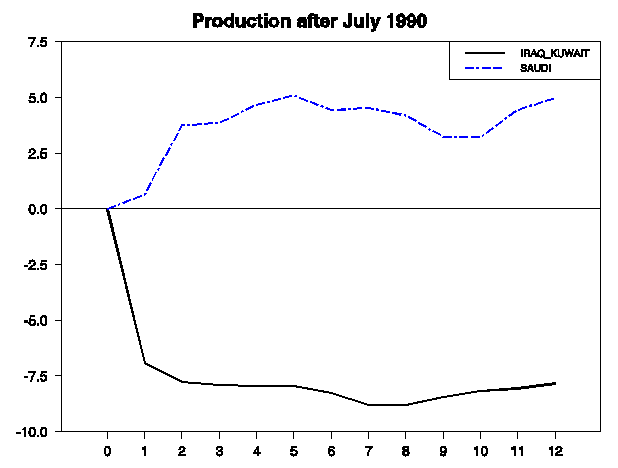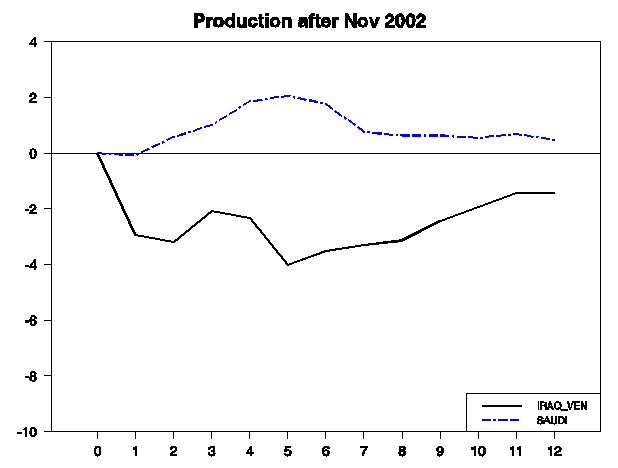One key question in determining the impact of instability in Libya and elsewhere on world oil markets is how much other countries can and will increase production to offset the shortfall. Here I review the critical role of Saudi Arabia in past disruptions and discuss the current situation.
Prior to the First Persian Gulf War in 1990, Iraq and Kuwait between them accounted for almost 9% of world oil production, which was essentially completely knocked out by the military conflict (see the black line in Figure 1). Fortunately, Saudi Arabia had substantial excess capacity, and their increased production amounted to almost 5% of global supplies at the time (blue line). This was a significant factor in limiting the size and duration of the spike in oil prices, and helped mitigate the severity of the 1990-91 economic recession.

|
A general strike eliminated 2.1 million barrels per day of oil production from Venezuela in December of 2002 and January of 2003. Shortly after, the Second Persian Gulf War disrupted a similar amount of Iraqi production, with the two combined creating up to a 4% shortfall at the low point (black line in Figure 2). Once again, increases in production from Saudi Arabia (blue line) were an important mitigating factor.

|
Figure 3 details Saudi production going back to 1973, with the two episodes highlighted above denoted as shaded regions. Throughout most of this period, the Saudis had been a force stabilizing oil prices, dropping production in an effort to moderate the price reductions in the 1980s, and increasing production in episodes like the two mentioned above.

|
But Saudi oil production looks quite different over the last few years, as highlighted in more detail in Figure 4. The kingdom’s production actually declined between 2005 and 2007. Although it subsequently increased, at the peak of oil prices in July of 2008 Saudi production was essentially only back to where it had been in 2005. The failure of Saudi production to increase between 2005 and 2008 in the face of booming demand for oil from the newly industrialized economies was in my opinion a key reason for the dramatic increase in oil prices over that period.

|
Subsequent to the 2008 peak in oil prices, the Saudis cut production, consistent with their historical role of moderating the extent of price declines. Saudi Oil Minister Ali al-Naimi claims that the kingdom currently has 3.5 mb/d excess capacity, though many analysts have expressed doubts about those claims.
An increase of a million barrels per day in Saudi production relative to reported November levels, some of which may have in fact already been implemented, would put them back up to where they were in July of 2008. If all of Libyan production gets knocked out, we’d need 1.8 mb/d to replace it. If the Saudis weren’t able or willing to go above those production levels in 2008 when oil was selling for over $140 a barrel, why would you expect them to do so now with West Texas only at $106?
My answer is, I don’t.
Note that Texas increased its oil production in response to attempted arab oil embargoes in 1956 and in 1967, but when the 1973 embargo rolled around, Texas oil production had peaked.
Our (Brown & Foucher) work suggests that Saudi Arabia, in 2005, was approximately at the same stage of depletion at which Texas, the prior swing producer, peaked in 1972.
Note that the BP data base shows that annual Saudi total petroleum liquids production in 2008 was about 270,000 bpd below their 2005 annual rate, but as always the real story is net oil exports.
It seems likely that 2011 will be the sixth year in a row that Saudi net oil exports will be below their 2005 annual rate of 9.1 mbpd, despite the fact that it appears that annual US spot crude oil prices will have exceeded the $57 level that we saw in 2005 for six straight years, with five of the six years showing year over year increases in annual oil prices. (Soon, the Saudis will have been showing declining net oil exports, relative to 2005, longer than the Second World War, 1939 to 1945).
Regarding Saudi Arabia, it’s really a story of two countries: (1) Saudi Arabia through 2005 and (2) the post-2005 Saudi Arabia.
Let’s look at 2002 to 2010 Saudi net oil exports versus US annual spot crude oil prices (EIA):
From 2002 to 2005, the Saudis responded to rising oil prices with sharp increases in net oil exports:
2002: 7.1 mbpd & $26
2003: 8.3 mbpd & $31
2004: 8.6 mbpd & $42
2005: 9.1 mbpd & $57
But then we have post-2005 Saudi Arabia, when the Saudis responded to generally rising oil prices with declining net oil exports:
2006: 8.4 mbpd & $66
2007: 8.0 mbpd & $72
2008: 8.4 mbpd & $100
2009: 7.3 mbpd & $62
2010: 7.4* mbpd & $79
*Estimated
Post-2005 Saudi Arabia has of course shown the same pattern as Texas after 1972, i.e., declining production, relative to a prior peak, in response to rising oil prices. The 1972 Texas peak (black) lined up with 2005 Saudi production (C+C):
http://i1095.photobucket.com/albums/i475/westexas/Slide10.jpg
In my opinion, what passes for excess capacity worldwide, including Saudi Arabia, largely consists of what Matt Simmons called “Oil stained brine.”
By increasing their output of “Oil stained brine” and by depleting inventories, I suspect that the Saudis could show some kind of short term boost in delivered oil, but I think that the time has passed when they could bring global prices down via a steady increase in net oil exports in excess of their 2005 annual rate. The Saudis have some new production coming on line, but that was true of other post-peak regions too.
For example, Sam Foucher looked at new oil fields in the North Sea whose first full year of production was 1999 or later, and these new oil fields had a peak of about one mbpd in 2005 (versus the overall peak of six mbpd in 1999). These new fields, equivalent, at peak, to one-sixth of 1999 production only served to slow the overall decline to about 5%/year.
BTW, there were certainly have two stock markets in Saudi Arabia: (1) Through 2005 and (2) Post-2005:
http://www.tradingeconomics.com/Economics/Stock-Market.aspx?symbol=SAR
Interesting coincidence that the Saudi stock market crashed at precisely the same point at which the Saudis started “voluntarily” reducing their net oil exports.
Remember the OPEC price band?
http://www.independent.co.uk/news/business/news/opec-studying-plan-to-bo…
April, 2004: Mr Al-Naimi said: “Saudi Arabia continues to be committed to OPEC’s $22-28 price band. There are signs that worldwide inventories have begun to build but no one really knows for sure. I do not believe there is a fissure [within Opec]. There is dialogue. Opec in general is committed to the band,” he said.
If NATO/US plans on supporting the rebels in Libya, will they do the same in Saudi Arabia against the House of Saud?
My answer is, me thinks not.
Oh what tangled webs we weave.
In the following early 2006 article, we made the case, using production data through 2005, that Saudi Arabia was on the verge of a production decline:
http://www.energybulletin.net/node/16459
Texas and US Lower 48 oil production as a model for Saudi Arabia and the world
A more recent article:
http://www.energybulletin.net/stories/2011-02-21/egypt-classic-case-rapid-net-export-decline-and-look-global-net-exports
Egypt, a classic case of rapid net-export decline and a look at global net exports
We currently have a full capacity of 775 million barrels of oil in the Strategic Petroleum Reserve. We should sell 200,000,000 barrels from there. This would make up for all of Libyan production for the next 4 months or so. The best part: it would also raise a couple of billion bucks. We could toss a billion toward deficit reduction (a drop in the bucket, yeah, but still), and spend the other billion on incentives to convert truck and bus fleets from diesel to natural gas. Let’s say it costs 10,000 per truck or bus to convert including refuelling infrastructure at the bus/truck depot(no idea if I’m in the ballpark). If the incentive picks up 50% of the tab and the prospect of using cheaper fuel gives the trucking/bus companies sufficient reason to go the rest of the way, that could be 200,000 high-use vehicles going from diesel to cleaner, cheaper, largely domestically available natural gas.
Benefits: stabilize oil markets, reduce defecit, reduce dependence on foreign oil, help shipping/transport industry save on fuel costs and help the trade deficit by switching to natural gas, and a slight improvement in pollution.
I do not believe the Sauds have the capacity anymore to ramp up production like they have done in the past. They have been blowing smoke about their reserves for years, and they have not had any big oil field developments in a long time (since the 80’s?). They are also concerned about ramp ups in prices, as newer energy technologies get a better chance to supplant their product.
Their internal appetite for energy has been growing the last decade, to the point where they now import significant amounts of diesel fuel. The old fields are petering out. New extraction techniques may help wring out more “last drops” but it won’t cover a 1-2M barrel increase.
(I’ve also noticed WTI is losing favor as the benchmark price for oil.)
Brent oil futures, the benchmark contract for European oil, rose $2.25, or 2%, to $115.31 a barrel on ICE Futures in London.
There was a report mentioned on FT Alphaville that posited that the Saudi’s had actually increased their output BEFORE the Libyan exports were shut down.
I also read somewhere that Saudi electricity use was rising at 10%/year. But I would guess they use gas for this?
Oil futures are no longer in contango, so anyone buying spot to store would be losing the ca. $.75/month storage cost. So at this point, the market must be absorbing current production, plus any that comes out of storage as older carry trades expire. I guess some of that could be hoarding by participants who don’t care about storage costs.
If the high spot price is merely fear/speculation driven, wouldn’t it collapse pretty quickly?
Because in the US, gasoline and related fuels is almost 4% of disposable income, like in ’08, and health care costs have continued to rise putting additional stress on budgets. Pop!
On Saudi –
In early 2008, it was apparent that Saudi was throwing in extra capacity as quickly as they were able to bring it on line. However, they never produced the last 0.9 mbpd of their nameplate capacity. I doubt they ever had it–it was pure bluff, left over from the days when they wanted to show extra capacity to deter competitors.
Notwithstanding, given that incremental Saudi capacity was added fairly quickly and at reasonable cost, I would conclude that Saudi is, in fact, able to increase production.
But how far? Right now, our pro forma narrative reads as follows:
The world sees a mini oil shock, as we currently have. This prompts the Saudis to increase production in the 400-700 kpbd range. The extra production cools markets and returns prices to more reasonable levels. However, the effect is transient, and within six months, we have another mini oil shock, and the Saudis again have to increase production. Budget this for Q3/Q4 2011.
Then there’s a a third mini shock, say, mid-year 2012, and the Saudis make their last production push, raising output to 10.5-11.2 mpbd. With this, King Abdullah declares, “We have done what we can. We must leave some oil in the ground for our children. While Saudi Arabia is committed to stability in oil markets, the Kingdom cannot solve the world’s oil demands by itself, and other countries must contribute.”
And then we’re done and the global economy repeats 2008 (or more precisely, 1979) and we suffer an oil shock and recession.
Note the timing on this. The next oil shock could come just before the next election (or sooner). If so, the Democrats will suffer another punishing electoral defeat. They are running completely unhedged with respect to oil policy–or, more precisely, Administration policy geared to prevent “the overproduction of oil and gas” and is prepared to countenance the collapse of Gulf of Mexico production, which is set to fall by 600,000 bpd by May 2012 (11% of US crude output), according to EIA.
Are battery-powered cars and wind turbines going to save us? Right now, the Democrats are betting all-or-nothing.
I’m looking forward to the piece entitled, “The Impact of a Near-term Oil Shock on US GDP, Employment, and Budget Balance”.
JDH: This has to be one of the most thorough, yet concise and balanced treatments of this subject I’ve read. I’d only add that Brent Crude is only at ~US$115/barrel. That and if Libya suffers sufficient war-related damage, most production for domestic consumption will no longer matter until well after security is fully restored.
For the moment…
I’m not sure what to think of the story that the Saudis are actively stockpiling oil outside the country and in the Red Sea. The Saudi oil minister Ali Naimi reported on Tuesday that his country ..” …was now “storing additional quantities of crude oil at various storage facilities”. ” according to the Financial Times. It raises questions about whether new stockpiles or additional sales are most beneficial at this specific time.
For what it’s worth, I think that it is unlikely that Saudi Arabia will ever again produce 9.6 mbpd (crude + condensate) 11.1 mbpd (total liquids), on an annual basis. But I think that it is extremely unlikely that they will ever again exceed their (2005) total liquids net export rate of 9.1 mbpd, on an annual basis.
From the point of view of oil importing countries, Saudi intent, post-2005 through 2010, is not terribly important, since the cumulative shortfall–between what they would have (net) exported at their 2005 annual rate and what they actually (net) exported–is in excess of two billion barrels of oil, through 2010.
Oil consumers are like someone who was just run down by a speeding 18 wheeler. Does it matter to person run down whether or not the driver was aiming for them?
The Saudis are claiming the run up in oil prices is due entirely to speculators and somehow this is supposed to be an argument for not increasing production. In other words, they want the world to believe that not ramping up production is a conscious decision by the Kingdom and not one forced upon it by the realities of peak oil in the desert. I think the Saudis are hoping that no one notices that the sheikh isn’t wearing any clothes.
Terrific and timely analysis, thanks.
The question is: did the Saudis lack the will to increase production further in 2008 or did they lack the ability? If they merely lacked the will they may find it this time with the hindsight knowledge that $140 barrel oil wasn’t self-sustaining.
My opinion is that the Saudi government believes that a continually more aggravated supply shortfall is certain in the world oil markets. They, and the G20 believe that the best way out of global economic dependence on oil is to allow prices to rise sufficiently so that alternative sources and more efficient utilization are implemented.
I’m sure that that the Saudi’s could ramp-up production by 2-3 MBpd for a month or two. The downside is that they would damage the extraction capacity of their fields in the process: Faster Production > Lower Total Yield….. Reminds me of US banking and fiscal policy. High current GDP > Lower Future Economic Activity.
With Brent going up sharply again, we are in for second peak in this graph,
http://www.saposjoint.net/Forum/download/file.php?id=2609
commencing yesterday, and peaking at around April 1st with Brent crude STABLE above 125 USD, with a possible short spike to 135 USD somewhere near the top.
After that, another downturn to during May Brent 110-115, and then, in June-July upturn to 140-150 USD peak. The scale on the graph is 5-8% below what is really happening, but , if USD strengthens, may be realistic. USD will strengthen still in 2011. Its curreny in which military protection of oil assets is bought.
The Stock market will of course move down all this time ( as it has started from February 18th) till middle May-middle June, with a small return before final realization the USA is heading for recession due to Oil prices and fiscal restraint, as easing to make oil more expensive and spend extra printed money on it makes no sense, as it does not contribute to growth:
http://www.saposjoint.net/Forum/download/file.php?id=2608
I published the graphs on February 6th, so there is some predictive power in them already.
When looking at the last OMR february report 2011 one may wonder whether or not, Saudi Arabia increased production does matter,except for itself.
OPEC produces 3m/bd less than in 2008,the shortfall being supplied by the rest of the world within an increased demand trend.” Highlights of the latest OMR dated: 10 February 2011″.
Libya in 2010 is representing 2.1% of the total oil production (Hamilton Libya, oil prices, and the economic outlook). Saudi Arabia (SA) bringing its existing share of the global oil output 11.7 % to 13.8% is a far fetched hope, when it seems proved (Hamilton Saudi oil reserves may be overstated by 40%).SA reserves may have reached a declining production trend.
Prices look being in a sweet spot,and chartists looking forward to see a double top or even better a melt up,never the less:
“OPEC crude supply scaled two-year highs in January at 29.85 mb/d, with Iraq underpinning the 280 kb/d monthly increase.”
By rough calculations, If Libyan oil production dropped by 30%, this would be equivalent to China increasing its oil demand by 10% over the course of a year, which seems conservative. So why are markets suddenly so discouraged? Were they ignoring the effects of growth on oil markets?
Looks as if North Dakota and Canada may be in for many years of budget surpluses.
all of you assume oil is fungible … saudi oil is not a replacement for libyan oil … libyan oil is light, very high gravity … saudi is heavy, sour … refineries would have to spend serious money to change over to saudi barrels … the political risk is oil
To the following question from Prof Hamilton, there is a very good reason for the Saudis to sell oil now when it didn’t in 2008.
“If the Saudis weren’t able or willing to go above those production levels in 2008 when oil was selling for over $140 a barrel, why would you expect them to do so now with West Texas only at $106?”
In 2008, the Saudis didn’t spend $40 billion to placate its populace. Not just the Saudis but many countries will sell. Popular unrest is expensive. Even Gaddifi, after all is said and done, will have to pay for his civil war.
As noted up the thread, what really counts is the volume of Saudi net oil exports, which averaged 7.9 mbpd (total petroleum liquids) for 2006 to 2010 inclusive, versus 9.1 mbpd in 2005. So, the failure of the Saudis to even match their 2005 net export rate has been going on for several years.
But if there is any topic that is more ignored in the MSM than “Net Export Math” (focusing on annual volumes), it’s the post-2005 CNE (Cumulative Net Export) depletion rate.
Here are recent Saudi net export data versus US annual spot crude oil prices (EIA):
2005: 9.1 mbpd & $57
2006: 8.4 mbpd & $66
2007: 8.0 mbpd & $72
2008: 8.4 mbpd & $100
2009: 7.3 mbpd & $62
2010: 7.4* mbpd & $79
*Estimated
Post-2005, the Saudis (net) exported a total of about 14.4 Gb (billion barrels) through 2010. As I frequently point out, if they had simply maintained their 2005 annual net export rate of 9.1 mbpd, they would have shipped 16.6 Gb.
But let’s do some “Cowboy Integration.” The area under a net export versus time graph is the total volume of net exports. Net export declines tend to show a triangular pattern, and we can approximate the total volume of post-peak net exports by multiplying the peak net export rate times the number of years of net exports remaining, times 1/2.
Sam Foucher’s most optimistic projection is that Saudi Arabia will approach zero net oil exports around 2036, which is 31 years of net exports, post-2005, which implies post-2005 CNE on the order of 50 GB of oil. So (rounding off), 14 Gb of post-2005 CNE through 2010 would be about 28% of post-2005 Saudi CNE, a post-2005 CNE depletion rate of about 7%/year.
Sam’s most optimistic projection is that Saudi Arabia, Russia, Norway, Iran and the UAE will have shipped half of their combined post-2005 CNE by the end of 2014. This is a projected (2005) top five post-2005 CNE depletion rate of about 8%/year.
Some observed post-peak CNE depletion rates:
Indonesia (Peak + 3 years), 31%/year;
UK (Peak + 2 years), 38%/year;
Egypt (Peak + 4 years), 19%/year.
If Japans nuclear plants experience meltdown, it will send oil price up immediately, as nuclear alternative will look less problem free.
Here are scenarious for oil and DJIA I charted on february 6th, so far they look good:
http://saposjoint.net/Forum/viewtopic.php?f=14&t=2626&start=0
http://saposjoint.net/Forum/download/file.php?id=2609
http://saposjoint.net/Forum/download/file.php?id=2608
I did not expect nuclear power problems to compound on supply problems from Oil producer revolutions, but, the curves does not depend on causes, they are systemic, the causes provide themselves readily, as we have seen so far.
The curves are the cumulative result of all unpredictable causes, but the curves themselves are predictable.
But a new problem arose Saturday night when the No. 3 reactor lost its emergency cooling system, renewing fears of a possible meltdown. Japan’s Nuclear and Industrial Safety Agency identified the new problem, according to media reports. and said it was urgently attempting to secure a means to supply to the reactor.
It wasn’t clear if the government and Tepco were planning a move similar to one taken to protect the damaged No. 1 reactor.